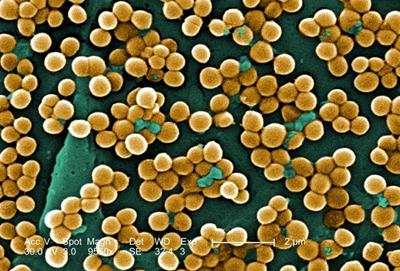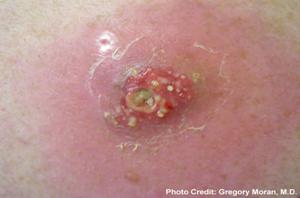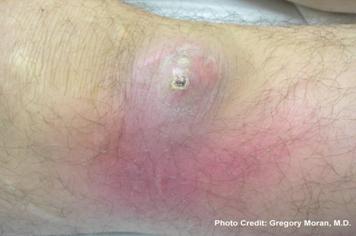Methicillin Resistant Staphylococcus (MRSA)
Staphylococcus Aureus (also known as ”Staph” or S. Aureus) is a common type of bacteria that normally lives on the skin and sometimes in the nasal passages of healthy people. MRSA stands for Methicillin Resistant Staphylococcus Aureus and is a type of S. Aureus that is resistant to a family of antibiotics (penicillin and related agents), normally used to treat this sort of infection. MRSA is an emerging, increasingly important issue for fire fighters and all people.
Under the microscope, S. Aureus looks like clusters of grapes:

While 25% to 30% of people in the United States carry staph bacteria in the nose, less than 2% carry MRSA.
How can you get it?
There are two types of MRSA infections:
- Healthcare-associated MRSA (HA-MRSA) infections happen in people:
- Who are or have recently been in a hospital or other health-care facility (nursing homes, dialysis centers, long term acute care centers)
- Have recently had surgery or other procedures
- Community-associated MRSA (CA-MRSA) infections happen in :
- Otherwise healthy people, who have not recently been in the hospital
- In athletes who play contact sports and/or share equipment or personal items (such as towels or razors)
- Children and workers in daycare facilities
- Military personnel and other people who live in other crowded and/or unsanitary conditions (military barracks, dormitories, correctional facilities)
People with weak immune systems have more serious infections. The number of CA-MRSA cases is increasing.
You can get MRSA:
- When your skin comes in “contact with someone’s (MRSA) skin infection or personal items they have used, like towels, bandages, or razors that touched their infected skin”
- Through openings in the skin such as cuts or abrasions (These opening can be visible or so small that they aren’t visible to the naked eye)
- By coming into contact with items and surfaces contaminated with MRSA
- By living or working in crowded situations, where there is close contact with others
- When you or others around you have poor hygiene
Fire Fighters are at risk of being exposed to both types of MRSA.
Symptoms
In the community, most MRSA infections are skin infections. Here is how a skin infection may appear:


- These infections usually start off as small red, white and/or yellow bumps that look like pimples, boils or spider bites. (http://www.mayoclinic.com/health/mrsa/DS00735/DSECTION=symptoms)
- These bumps can be red, swollen, warm to the touch, painful and can have pus or other body fluids draining from them.
- These skin infections commonly occur where there as breaks in the skin (cuts and abrasions) and body areas with hair (e.g., back of neck, groin, buttock, armpit, beard area of men).
- These bumps can quickly turn into deep, painful abscesses that require drainage by a medical professional.
Severe infections can occur if this infection is not treated properly and/or if your immune system isn’t working properly. In these situations, the MRSA skin infection can get worse and can spread to the rest of the body (including the blood, bones, lungs and other organs). The symptoms in severe infections vary by location and extent of infection.
Prevention
- Using Universal Precautions
- Hand hygiene (wash with soap and water or using an alcohol based hand rub)
- Personal protective equipment (PPE) (gloves, gowns, masks and goggles that offer mouth, nose and eye protection)
- Proper handling and disposal of instruments/devices and clothing contaminated with blood or body fluids
- Keep yourself and your environment clean by:
- Using other barriers, like clothing or towels, between you any surfaces you share with others (like gym equipment)
- Showering immediately after having direct skin contact with others
- Decontaminating regularly used clothing and equipment;Check out the “Environmental Cleaning & Disinfecting for MRSA” section of the CDC at this link http://www.cdc.gov/mrsa/environment/index.html for more details.
- Keeping personal items personal. Avoid sharing personal items such as towels, razors, clothing, bedding
- Wound Hygiene
- Avoid contact with other people’s wounds or bandages.
- Keep cuts and scrapes clean and covered with a bandage until healed.
What should you do if you are exposed or have symptoms of MRSA disease?
You should see a doctor or health care professional if you:
- Start developing worsening symptoms of skin infections (described above in the What are the symptoms? section)
- If you develop fever or feel unwell with this skin infection
The doctor may:
- Get a culture of some of the pus/drainage from your infection
- Perform nasal swabs
- Offer abscess drainage and/or specialized antibiotics for MRSA infections
A doctor in a hospital can provide advanced care for severe MRSA infections. Do not try to drain an abscess on your own because this may increase the risk of worsening or spreading the infection.
You should:
- Keep cuts, scrapes, boils and draining skin areas clean and covered with a bandage until healed, so that you do not infect others or spread the infection to other parts of your own body.
- Properly dispose of these bandages, as per your fire department’s infection/exposure control plan.
MRSA is not on the current CDC Nationally Notifiable Infectious Disease List. However, it is a reportable disease in many states, so check with your local state health department to see if you should report this in your state.